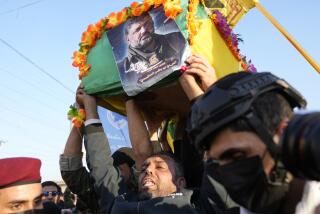Iraq Cleric Faces Showdown With Moderate Shiites
- Share via
BAGHDAD — U.S. and British forces have recently inflicted heavy casualties on Muqtada Sadr’s militia, but the Shiite cleric is bracing for a showdown with a more familiar foe: moderate Shiites who do not support his uprising.
A senior Shiite leader, Sadruddin Qubanchi, allied with the powerful Supreme Council for Islamic Revolution in Iraq, has called for a mass demonstration Friday in the holy city of Najaf to expel Sadr’s private army.
Sadr, who has long been at odds with the Shiite establishment in Najaf, responded with a call of his own. An aide told followers that it was time to intensify their battles with the U.S.-led occupation.
Sadr has apparently calculated that his enemies -- both foreign and domestic -- have come together to force him out.
U.S. officials have been open about their attempts to woo moderate Shiites to defeat Sadr’s ragtag Al Mahdi militia.
“We have been meeting with local sheiks, local religious leaders, local businesses,” said Brig. Gen. Mark P. Hertling of the 1st Armored Division, which dispatched about 2,500 troops to the Najaf area last month after Sadr’s uprising began. “The message from everyone is that no one likes Muqtada. Everyone wants law and order installed again.”
Both sides have made a high-stakes gamble by calling on their followers to show their strength. Shiites, who make up 60% of the Iraqi population, risk creating divisions that could undermine their ability to claim political power in the coming months when Iraq gears up for independent elections.
Since early April, Sadr has been stoking an uprising in southern Iraq and in a Baghdad neighborhood known as Sadr City, named for his father, a beloved Shiite cleric who was assassinated by Saddam Hussein’s regime.
Sadr’s forces suffered heavy losses in recent clashes with U.S. troops in Sadr City and with British forces in the southern cities of Basra and Amarah.
U.S. forces were also able to arrest two of Sadr’s top aides on Saturday during an operation in Sadr City.
Those arrests, commanders said, probably triggered the intense fighting Sunday and early Monday in Sadr City.
Groups of armed young men attempted to block off streets and take over police stations -- the same strategy that worked for the militant cleric in Najaf and Kufa.
In the latest attacks, U.S. troops responded with armored vehicles and aircraft support.
“They blocked some roads, decided to show their faces and they lost their lives,” said Gen. Jeffrey Hammond of the 1st Cavalry Division, which fought pitched battles with Sadr’s forces last weekend in Sadr City.
Hammond said his forces killed 35 militiamen. “They are an armed militia. And armed militias are dangerous.”
On Monday, supporters of Sadr picked through the ruins of the headquarters destroyed by U.S. firepower and salvaged photographs of the militant cleric and his late father. They struck a defiant tone and vowed to fight on.
The younger Sadr, believed to be in his 30s, receives much of his support from disaffected young men who are drawn to his militancy and anti-U.S. rhetoric.
Sadr has never been a favorite of the Shiite establishment, but even conservative Shiite leaders have warned U.S. officials that taking direct action against the militant cleric could be counterproductive.
But in recent days, moderate Shiites have begun to complain openly about Sadr.
On Monday, demonstrators supportive of moderate Shiite groups marched through Najaf’s serpentine streets leading to the Imam Ali shrine. Pro-Sadr recruits tried unsuccessfully to block their entry.
“All the people are with Sadr!” shouted the cleric’s militiamen. “Death for Baathists.”
Supporters of his rivals responded: “All the people are with Sayid Ali Al Sistani.”
That was a reference to Grand Ayatollah Ali Sistani, the senior Shiite cleric in the country and, according to a recent poll, the most popular figure in Iraq.
Sistani has close ties to the Supreme Council for Islamic Revolution in Iraq, the influential group linked to the call for Friday’s demonstration.
Many Najafis believe that Sadr’s uprising is affecting their livelihood. Since Hussein’s ouster, multitudes of visiting pilgrims boosted business in the city. But pilgrims have stopped coming since Sadr moved in with his armed men to occupy the shrine.
A Shiite-led move to oust Sadr is good news for the U.S. It avoids the need for coalition troops to confront Sadr’s forces directly in what could be a bloody battle near Imam Ali’s shrine, among the most sacred for Shiites.
Such a Shiite action would also support the oft-repeated U.S. position that Sadr is a marginal leader disrupting the nation’s economic and political development.
“They’re against the real progress that the people of Sadr City want,” Hammond said.
Some fear that U.S. efforts to kill or capture him, as the top U.S. commander in Iraq has vowed to do, could set the stage for a long-term Shiite revolt that could prove as hard to put down as the Sunni Muslim revolt against the U.S. occupation.
“The Sunni insurgency, in one part of the country, has in many ways paralyzed the American enterprise in Iraq just by itself,” said Juan Cole, a professor of modern Middle Eastern history at the University of Michigan.
“Another long-term insurgency among the Shiite could make the situation untenable.... It could be a disaster.”
Staff writer Raheem Salman in Najaf and special correspondent Saif Rasheed in Baghdad contributed to this report.
More to Read
Sign up for Essential California
The most important California stories and recommendations in your inbox every morning.
You may occasionally receive promotional content from the Los Angeles Times.













